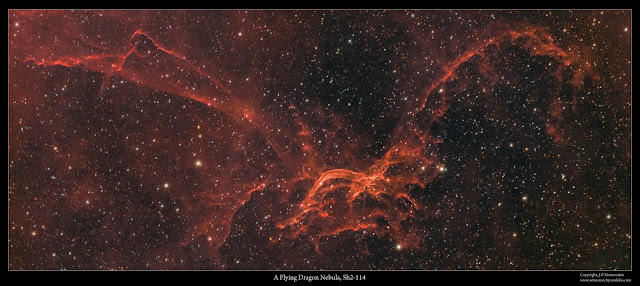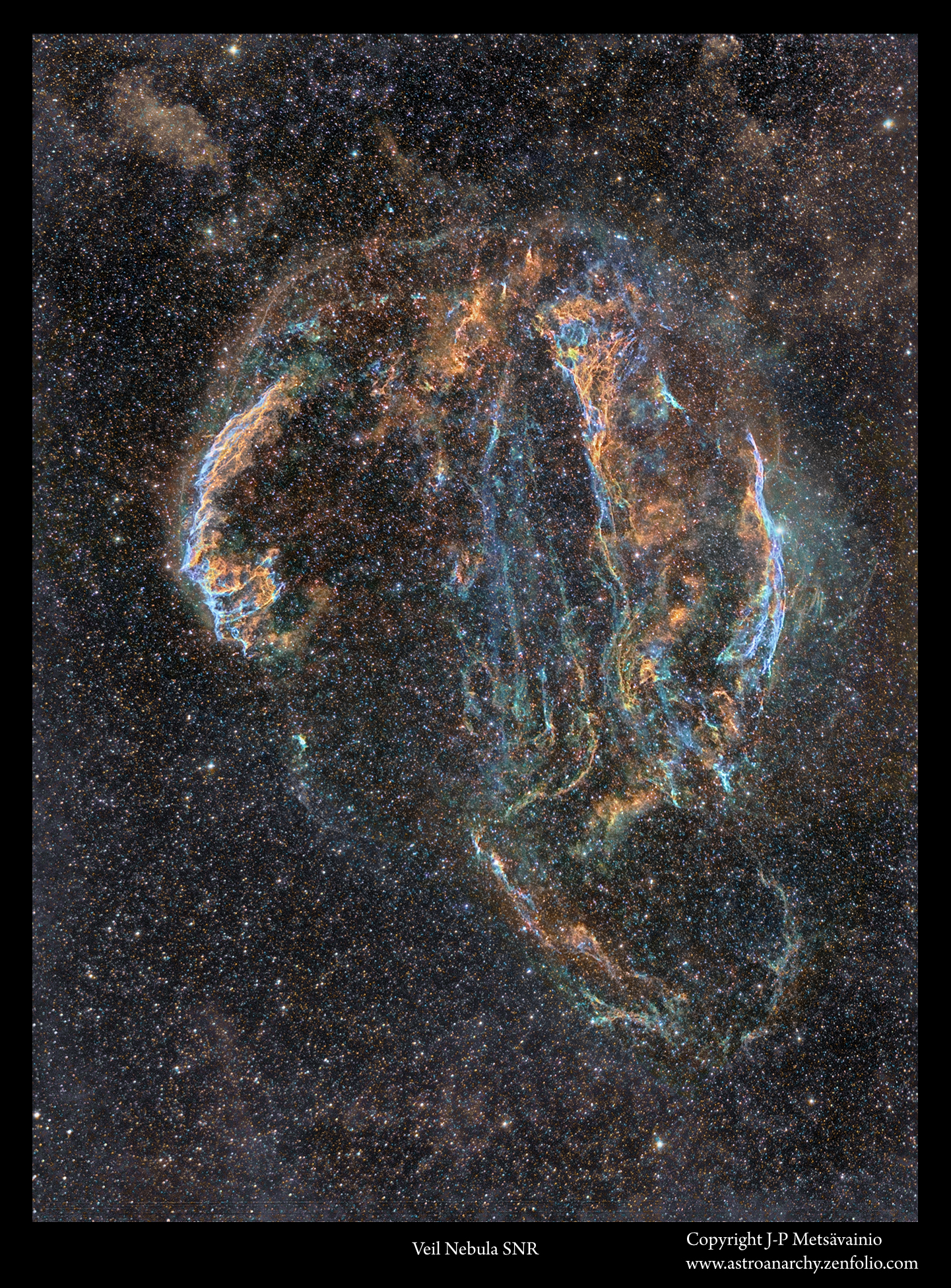COPYRIGHT, PLEASE NOTE
All the material on this website is copyrighted to J-P Metsavainio, if not otherwise stated. Any content on this website may not be reproduced without the author’s permission.
Have a visit in my portfolio
PORTFOLIO:https://astroanarchy.zenfolio.com/
Saturday, August 27, 2016
Cinemascope format panoramas from my astro photos
While waiting to image season to start up here, I have worked with a cinemascope format movie theatre presentation from my photos. This is an extra wide ~21:9 format used in movie theaters. The actual film is not ready yet but I have some of my images converted to this ultra wide format. I think they will look great at a large movie screen! I'll publish some of individual panoramic format photos here, images are downscaled for the web.
Cinemascope format image of the Sharpless 114 (Sh2-114)
The Flying Dragon Nebula, in eastern Cygnus, be sure to click for a full resolution version!

Natural color composition from the emission of ionized elements.
More info and the technical details about my photo can be found from HERE
INFO
Sh2-114 is a complex and unusual HII emission nebula. Its complex, wispy structure is likely the result of winds from hot, massive stars interacting with the magnetic fields in the interstellar medium. But very little is known about it. (Source, https://www.noao.edu/image_gallery/html/im1112.html)
Labels:
Narrowband color images,
nebula
Monday, August 22, 2016
Pickering's Triangle reprocessed
This shot about the Pickering's Triangle was my opening image for the Autumn season 2015.
It was also selected for a Astronomy Picture of the Day (APOD) by the NASA.
I'm waiting to new imaging season to start. To practise my astronomical image processing skills, I have reprocessed the whole dataset, about 20 hours of exposures.
Be sure to click for a large image!
The final photo has now better details and little bit more vivid colors. You can see the previous version in the original blog post HERE. Colors are from the ionized elements, Hydrogen, Sulfur and Oxygen. S-II = Red, H-alpha = Green and O-III = Blue.
A closeup
Be sure to click for a large image!
An experimental starless version
Be sure to click for a large image!
Details in this complex supernova remnant are easier to see when the stars are suppressed. It looks kind of spooky too.
The whole two frame mosaic in cinemascope format
Be sure to click for a large image!
A wide field photo shows the whole Veil Nebula supernova remnant
The Pickering's Triangle can be see at one o'clock position.
My blog post about the wide field shot can be seen HERE.
Technical details
Processing work flow
Image acquisition, MaxiDL v5.07.
Stacked and calibrated in CCDStack2.
Deconvolution with a CCDStack2 Positive Constraint, 33 iterations, added at 33% weight
Color combine in PS CS3
Levels and curves in PS CS3.
Imaging optics
Celestron Edge HD 1100 @ f7 with 0,7 focal reducer for Edge HD 1100 telescope
Mount
10-micron 1000
Cameras and filters
Imaging camera Apogee Alta U16 and Apogee seven slot filter wheel
Guider camera, Lodestar x2 and SXV-AOL
Astrodon filter, 5nm H-alpha
Astrodon filter, 3nm O-III
Astrodon filter, 3nm S-II
Exposure times
H-alpha, 15 x 1200s = 5h
O-III, 36 x 1200s binned = 12h (Autumn 2014)
S-II, from my older wide field photo of the Veil Nebula = 3h
Total 20h
Labels:
Narrowband color images,
nebula
Astro anarchy gets published, Large print of the central Cygnus
This large 100 x 400 cm (3.3 x 13.2 feets) print out of my photo of the Cygnus is located in Creative Laboratory (Luova Laboratorio) Oulu, Finland.
A large print
Please, click for a full size photo
Image is printed on canvas with an aluminium frame. The size is 100 x 400 cm (3.3 x 13.2 feets)
This is a very high resolution mosaic image and it can be printed even much larger scale without losing any sharpness. The printed photo is actually a part from a large mosaic picture of constellation Cygnus. The whole 18-panels mosaic can be seen HERE
Older large public artworks out of my photos
Path of Swans, Svenska Private School, Oulu, Finland, 2014
Print on aluminium, 360 x 160 (142 x 63 inch) More info HERE
Print on aluminium, over 3 x 10 meters (10 x 33 feets) More info HERE
Labels:
publications
Saturday, August 20, 2016
An experimental 3D-study of the Great galaxy of Andromeda, M31
This is an experimental test with a 3D-conversion of my astronomical image. Only real elements from the original image are used, there is nothing added but the estimated volumetric information!
NOTE. This is a personal vision about shapes and volumes, based on some scientific data, deduction and an artistic impression.
Video
This is a looped video, click to start and stop. Original movie is in HD 1080p resolution.
All the foreground stars from the original image are removed. Starlike objects seen in this animation are actually globular clusters orbiting the Andromeda Galaxy. Click the YouTube logo at lower right corner to see this video in YouTube at full screen, you should set quality to HD 1080p,Original 2d-image used for this 3d-study
An original blog post with imaging details can be found from HERE
Info about the technique used
Due to huge distances, real parallax can't be imaged in most of the astronomical objects.
I have developed an experimental technique to convert my astropics to a artificial volumetric models.
My 3-D experiments are a mixture of science and an artistic impression. I collect distance and other information before I do my 3-D conversion. Usually there are known stars, coursing the ionization, so I can place them at right relative distance. If I know a distance to the nebula, I can fine tune distances of the stars so, that right amount of stars are front and behind of the object.
I use a “rule of thumb” method for stars: brighter is closer, but if a real distance is known, I'm using that. Many 3-D shapes can be figured out just by looking carefully the structures in nebula, such as dark nebulae must be at front of the emission nebulae in order to show up etc...
The general structure of many star forming regions is very same, there is a group of young stars, as an open cluster inside of the nebula. The stellar wind from the stars is then blowing the gas away around the cluster and forming a kind of cavitation – or a hole — around it. The pillar-like formations in the nebula must point to a source of stellar wind, for the same reason.
How accurate the final model is, depends how much I have known and guessed right. The motivation to make those 3-D-studies is just to show, that objects in the images are not like paintings on the canvas but really three dimensional objects floating in the three dimensional space. This generally adds a new dimension to my hobby as an astronomical imager.
Labels:
Astronomical Videos
Subscribe to:
Posts (Atom)


















